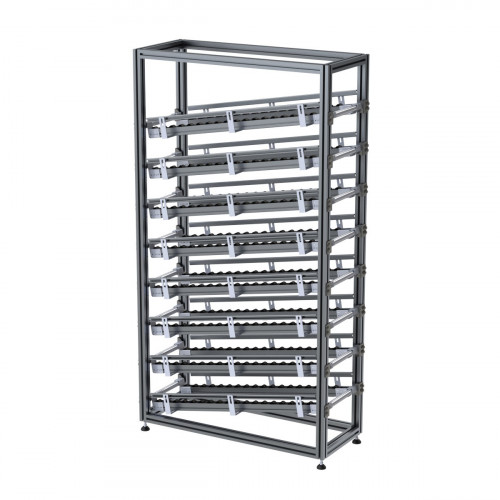Lean Manufacturing
Would you like to learn more about lean manufacturing or inquire about ordering a custom-built manufacturing flow rack?
WHEN YOU REACH OUT TO US, PLEASE PROVIDE THE FOLLOWING:
- Type of product, packing, or container to be racked, and weight of each
- Dimensions (width, length, height) of flow rack to be installed
- Dimensions of space where the lean manufacturing unit will be situated, including loading aisle and picking aisle
- Number of levels to be included
- Anchoring options (e.g., bolted to floor, wall, table top, etc.)
- Any other additional information—even hand-drawn sketches—to help us get an idea of the total scope of your project
- Any special equipment attachments or accessories desired
- When selecting accessories for your T-slot aluminum build, please make sure that they match the t-slot size of your framing system
A Brief History of Lean Manufacturing
As with most abstract concepts, the idea of “lean manufacturing” cannot be ascribed to any single person or time period. It has evolved over time, with conceptual contributions and adjustment made by different individuals and groups over various spans of time. As a business protocol, it can arguably be traced all the way back to Poor Richard’s Almanack, an annual handbook published continually from 1732 to 1758 by Benjamin Franklin, in which he wrote about the advantages of frugality and the virtues of working and spending wisely (e.g., “Spare and have is better than spend and crave.”). His thoughts on the subject were expanded upon further in his 1758 long-form essay, The Way to Wealth.
The way to wealth is as plain as the way to market. It depends chiefly on two words, industry and frugality: that is, waste neither time nor money, but make the best use of both. Without industry and frugality nothing will do, and with them everything.
Fast-forward to the early part of the 20th century, when American mechanical engineer and management consultant Frederick Taylor published his groundbreaking book, The Principles of Scientific Management, which essentially codified and modernized Franklin’s own scattered thoughts on the subject. As evidence of the revolutionary importance of this book, in 2001 the Academy of Management voted it the most influential management book of the twentieth century.
Further along, in the 1930s, Japanese industrial engineers Shigeo Shingo and Taiichi Ohno of Toyota applied their thinking on efficiency to manufacturing procedures at Toyota. The results of their methods were so spectacular that other business authors began taking notice and writing about Toyota and its successes. It was John Krafcik, working as a production researcher and consultant at MIT, who in 1988 applied the term “lean manufacturing” to those methods. Author James Womack formally defined the term in his 1991 book, The Machine That Changed the World: The Story of Lean Production, further detailed in the 1996 book Lean Thinking: Banish Waste and Create Wealth in Your Corporation.
What Do We Mean by “Lean Manufacturing?
As the term implies, lean manufacturing is a manufacturing and production method based on the ideals of maximizing productivity while at the same time minimizing either material or monetary waste. In the method, “waste” is defined as anything that doesn’t add value to the product being manufactured.
Lean manufacturing is beneficial to most manufacturing processes in that it reduces operating costs, shortens production time, and improves the quality of the product being manufactured.
How Does Lean Manufacturing Work
To see lean manufacturing in action, look no further than the example of the Framing Tech Flow Rack Kit on this page. It adheres to the core principles of lean manufacturing in the following ways:
- The primary construction material is extruded T-slot aluminum which is strong yet light, durable, plentiful in the Earth’s crust, and corrosion-resistant.
- The rack draws no external power, using the laws of gravity and inertial force (which cost nothing) to move large quantities of products with maximum efficiency, thereby cutting down on pollution and reducing power costs.
- The FIFO model (“first in, first out”) inherent in flow racks assures that age-sensitive products, such as foods and medications, are used in the order they are produced, thereby cutting down on waste.
- By reducing the amount of physical labor (lifting, shifting, bending, carrying, etc.) workers need to do, the company cuts down on lost work time and insurance costs.
- Because flow racks literally create efficient flow, they reduce lead time, production delays, bottlenecks, and other obstacles to efficiency.
- Best of all, the modular nature of Framing Tech’s T slot aluminum builds means you are not stuck with a one-size-fits-all fabrication that may not exactly suit your requirements. Let us know what you need, and we will do our best to accommodate you!








